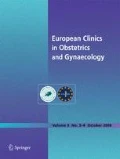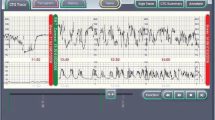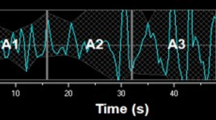Abstract
Waveform analysis of the foetal electrocardiogram (FECG) has been studied from physiological, signal processing and clinical aspects. Two randomised controlled trials (RCT) have been performed during the last 20 years, monitoring high-risk labours with cardiotocography (CTG) only or combining CTG with the ST waveform analysis of the FECG. A significant decrease in neonates born with metabolic acidosis in cord artery blood was observed, along with a decrease of operative deliveries for foetal distress. Blinded assessment of neonatal outcome in the latest RCT revealed an improvement of the Apgar score and the need for intensive care and neonatal encephalopathy when monitoring with CTG in combination with FECG. Also, the interobserver agreement for ST analysis was higher than for CTG alone. The system ability of the STAN technology, including an educational model, was studied in several European University clinics as an EU-supported project. During the last 6 months, the project confirmed the incidence of metabolic acidosis (0.64%) and moderate/severe encephalopathy in the earlier RCT on using ST information in addition to CTG. The available evidence suggests that the expected outcome could be achieved in most clinics, with a special focus on systematic teaching and training. Compared to ST analysis, foetal blood sampling (FBS) for pH analysis is technically complicated and, because it only presents momentary information, needs to be repeated to give adequate information. The STAN method provides continuous on-line information. ST waveform analysis in addition to CTG has the potential to give significant benefits in reducing operative deliveries for foetal distress and reducing the incidence of metabolic acidosis. However, this will depend on the appropriate education and use of STAN according to the guidelines provided.





Similar content being viewed by others
References
Thacker SB, Stroup D, Chang M (2001) Continuous electronic heart rate monitoring for fetal assessment during labor. The Cochrane Database of Systematic Reviews, issue 2, article no CD000063
MacDonald D, Grant A, Sheridan-Pereira M, Boylan P, Chalmers I (1985) The Dublin randomized controlled trial of intrapartum fetal heart rate monitoring. Am J Obstet Gynecol 152(5):524–539
Grant A, O’Brien N, Joy MT, Hennessy E, MacDonald D (1989) Cerebral palsy among children born during the Dublin randomised trial of intrapartum monitoring. Lancet 2(8674):1233–1236
Westgate J (1993) An evaluation of electronic fetal monitoring with clinical validation of ST waveform analysis during labour. PhD thesis, University of Plymouth, UK
Boehm FH (1999) Intrapartum fetal heart rate monitoring. Obstet Gynecol Clin North Am 26(4):623–639
Confidential enquiry into stillbirths and deaths in infancy (CESDI) (1995) Highlights of the 4th annual report. Pract Midwife 1
Hon EH, Quilligan EJ (1967) The classification of fetal heart rate. II: a revised working classification. Conn Med 31(11):779–784
Nielsen PV, Stigsby B, Nickelsen C, Nim J (1987) Intra- and inter-observer variability in the assessment of intrapartum cardiotocograms. Acta Obstet Gynecol Scand 66(5):421–424
Donker DK, Van Geijn HP, Hasman A (1993) Interobserver variation in the assessment of fetal heart rate recordings. Eur J Obstet Gynecol Reprod Biol 52(1):21–28
Bernardes J, Costa-Pereira A, Ayres-de-Campos D, van Geijn HP, Pereira-Leite L (1997) Evaluation of interobserver agreement of cardiotocograms. Int J Gynaecol Obstet 57(1):33–37
Blix E, Sviggum O, Koss KS, Oian P (2003) Inter-observer variation in assessment of 845 labour admission tests: comparison between midwives and obstetricians in the clinical setting and two experts. BJOG 110(1):1–5
Blix E, Oian P (2001) Labor admission test: an assessment of the test’s value as screening for fetal distress in labor. Acta Obstet Gynecol Scand 80(8):738–743
Keith RD, Beckley S, Garibaldi JM, Westgate JA, Ifeachor EC, Greene KR (1995) A multicentre comparative study of 17 experts and an intelligent computer system for managing labour using the cardiotocogram. Br J Obstet Gynaecol 102(9):688–700
MacLennan A (1999) A template for defining a causal relation between acute intrapartum events and cerebral palsy: international consensus statement. BMJ 319(7216):1054–1059
Murphy KW, Johnson P, Moorcraft J, Pattinson R, Russell V, Turnbull A (1990) Birth asphyxia and the intrapartum cardiotocograph. Br J Obstet Gynaecol 97(6):470–479
Nelson KB, Dambrosia JM, Ting TY, Grether JK (1996) Uncertain value of electronic fetal monitoring in predicting cerebral palsy. N Engl J Med 334(10):613–618
Impey L, Reynolds M, MacQuillan K, Gates S, Murphy J, Sheil O (2003) Admission cardiotocography: a randomised controlled trial. Lancet 361(9356):465–470
Westgate J, Harris M, Curnow JS, Greene KR (1993) Plymouth randomized trial of cardiotocogram only versus ST waveform plus cardiotocogram for intrapartum monitoring in 2400 cases. Am J Obstet Gynecol 169(5):1151–1160
Amer-Wahlin I, Hellsten C, Noren H, Hagberg H, Herbst A, Kjellmer I, Lilja H, Lindoff C, Mansson M, Martensson L, Olofsson P, Sundstrom A, Marsal K (2001) Cardiotocography only versus cardiotocography plus ST analysis of fetal electrocardiogram for intrapartum fetal monitoring: a Swedish randomised controlled trial. Lancet 358(9281):534–538
Symonds EM, Sahota D, Chang A (2001) Fetal electrocardiography. Imperial College Press, London
Widmark C, Lindecrantz K, Murray H, Rosen KG (1992) Changes in the PR, RR intervals and ST waveform of the fetal lamb electrocardiogram with acute hypoxemia. J Dev Physiol 18(3):99–103
Luzietti R, Erkkola R, Hasbargen U, Mattson LA, Thoulon JM, Rosen KG (1997) European community multicentre trial “Fetal ECG analysis during labour”: the PR interval. J Perinat Med 25(1):27–34
Westgate JA, Gunn AJ, Bennet L, Gunning MI, de Haan HH, Gluckman PD (1998) Do fetal electrocardiogram PR-RR changes reflect progressive asphyxia after repeated umbilical cord occlusion in fetal sheep? Pediatr Res 44(3):297–303
Fenn WO (1939) The deposition of potassium and phosphate with glycogen in rat livers. J Biol Chem 128:297–308
Hokegard KH, Eriksson BO, Kjellmer I, Magno R, Rosen KG (1981) Myocardial metabolism in relation to electrocardiographic changes and cardiac function during graded hypoxia in the fetal lamb. Acta Physiol Scand 113(1):1–7
Wohlfart B (1987) A simple model for demonstration of STT-changes in ECG. Eur Heart J 8(4):409–416
Sundstrom A-K, Rosen D, Rosen KG (2000) Fetal surveillance. Neoventa Medical, Gothenburg, Sweden
Rosen KG, Kjellmer I (1975) Changes in the fetal heart rate and ECG during hypoxia. Acta Physiol Scand 93(1):59–66
Dawes GS, Mott JC, Shelley HJ (1959) The importance of cardiac glycogen for the maintenance of life in foetal lambs and newborn animals during anoxia. J Physiol 146(3):516–538
Rosen KG, Isaksson O (1976) Alterations in fetal heart rate and ECG correlated to glycogen, creatine phosphate and ATP levels during graded hypoxia. Biol Neonate 30:17–24
Greene KR, Dawes GS, Lilja H, Rosen KG (1982) Changes in the ST waveform of the fetal lamb electrocardiogram with hypoxemia. Am J Obstet Gynecol 144(8):950–958
Stern L, Lind J, Kaplan B (1961) Direct human fetal electrocardiography (with studies of the effect of adrenaline, atropine, clamping of the umbilical cord and placenta separation of the fetal ECG). Biol Neonate 3:49
Lagercrantz H, Bistoletti P (1977) Catecholamine release in the newborn infant at birth. Pediatr Res 11(8):889–893
Hokegard KH, Karlsson K, Kjellmer I, Rosen KG (1979) ECG-changes in the fetal lamb during asphyxia in relation to beta-adrenoceptor stimulation and blockade. Acta Physiol Scand 105(2):195–203
Westgate JA, Bennet L, Brabyn C, Williams CE, Gunn AJ (2001) ST waveform changes during repeated umbilical cord occlusions in near-term fetal sheep. Am J Obstet Gynecol 184(4):743–751
Widmark C (1991) Fetal electrocardiogram relationships to oxygen lack, maturation and growth retardation. An experimental study. Dept of Physiology, University of Gothenburg, Sweden
Rosen KG (2001) Intrapartum fetal monitoring and fetal ECG–time for a change. Arch Perinat Med 7:7–12
Braunwald E, Maroko PR (1976) ST-segment mapping. Realistic and unrealistic expectations. Circulation 54(4):529–532
Gennser G, Nilsson E (1968) The relation between the action potential and the active state in human fetal myocardium and its dependence on muscle length and contraction frequency. Acta Physiol Scand 73(1):42–53
Gelli MG, Gyulai F (1969) Effect of glucose infusion in the mother before delivery on the ECG of rabbit foetuses under anoxia. Acta Obstet Gynecol Scand 48(1):56–63
Pardi G, Uderzo A, Tucci E, Arata GD (1972) Effect of hypoxia on the electrocardiogram and other cardiovascular parameters of the mature sheep fetus. Preliminary results. Minerva Ginecol 24(10):541–543
Myers RE (1972) Two patterns of perinatal brain damage and their conditions of occurrence. Am J Obstet Gynecol 112(2):246–276
Yeh MN, Morishima HO, Niemann WH, James LS (1975) Myocardial conduction defects in association with compression of the umbilical cord. Experimental observations on fetal baboons. Am J Obstet Gynecol 121(7):951–957
Lilja H, Greene KR, Karlsson K, Rosen KG (1985) ST waveform changes of the fetal electrocardiogram during labour—a clinical study. Br J Obstet Gynaecol 92(6):611–617
Rosen KG, Hrbek A, Karlsson K, Kjellmer I (1986) Fetal cerebral, cardiovascular and metabolic reactions to intermittent occlusion of ovine maternal placental blood flow. Acta Physiol Scand 126(2):209–216
Dagbjartsson A, Herbertsson G, Stefansson TS, Kjeld M, Lagercrantz H, Rosen KG (1989) Beta-adrenoceptor agonists and hypoxia in sheep fetuses. Acta Physiol Scand 137(2):291–299
Watanabe T, Okamura K, Tanigawara S, Shintaku Y, Akagi K, Endo H, Yajima A (1992) Change in electrocardiogram T-wave amplitude during umbilical cord compression is predictive of fetal condition in sheep. Am J Obstet Gynecol 166(1 Pt 1):246–255
Rosen KG, Lilja H, Hokegard KH, Kjellmer I (1985) The relationship between cerebral cardio-vascular and metabolic functions during labour in the lamb fetus. In: The physiol development of fetus and newborn, Academic Press, London, pp 461–465
Widmark C, Jansson T, Lindecrantz K, Rosen KG (1991) ECG waveform, short term heart rate variability and plasma catecholamine concentrations in response to hypoxia in intrauterine growth retarded guinea-pig fetuses. J Dev Physiol 15(3):161–168
Cremer M (1906) Uber die direkte Ableitung der Aktonsstrøme des mensclichen Herzen vom Oesophagus, und uber das Elektrokardiogramm des Føtus. Munch med Wschr 53:811
Einthoven W (1902) Galvanometric registration of the human electrocardiogram. Eduard Ijdo, Leiden, The Netherlands, pp 101–106
Hon EH (1963) Instrumentation of fetal heart rate and fetal electrocardiography. II: a vaginal electrode. Am J Obstet Gynecol 86:772–784
Hon EH, Lee ST (1965) The fetal electrocardiogram. 3: display techniques. Am J Obstet Gynecol 91:56–60
Larks SD, Longo LD (1962) Electrocardiographic studies of the fetal heart during delivery. Obstet Gynecol 19:740–747
Larks SSD, Larks GG (1966) Comparative aspects of the fetal and newborn electrocardiograms. Evidence for the validity of the method for calculation of the electrical axis of the fetal heart. Am J Obstet Gynecol 96(4):553–555
Pardi G, Tucci E, Uderzo A, Zanini D (1974) Fetal electrocardiogram changes in relation to fetal heart rate patterns during labor. Am J Obstet Gynecol 118(2):243–250
Marvell CJ, Kirk DL, Jenkins HM, Symonds EM (1980) The normal condition of the fetal electrocardiogram during labour. Br J Obstet Gynaecol 87(9):786–796
Jenkins HM, Symonds EM, Kirk DL, Smith PR (1986) Can fetal electrocardiography improve the prediction of intrapartum fetal acidosis?. Br J Obstet Gynaecol 93(1):6–12
Rosen KG, Lindecrantz K (1980) STAN—the Gothenburg model for fetal surveillance during labour by ST analysis of the fetal electrocardiogram. Clin Phys Physiol Meas 10(Suppl B):51–56
Lindecrantz KG, Lilja H, Widmark C, Rosen KG (1988) Fetal ECG during labour: a suggested standard. J Biomed Eng 10(4):351–353
Newbold S, Wheeler T, Clewlow F (1991) Comparison of the T/QRS ratio of the fetal electrocardiogram and the fetal heart rate during labour and the relation of these variables to condition at delivery. Br J Obstet Gynaecol 98(2):173–178
Lilja H, Arulkumaran S, Lindecrantz K, Ratnam SS, Rosen KG (1988) Fetal ECG during labour: a presentation of a microprocessor system. J Biomed Eng 10(4):348–350
Arulkumaran S, Lilja H, Lindecrantz K, Ratnam SS, Thavarasah AS, Rosen KG (1990) Fetal ECG waveform analysis should improve fetal surveillance in labour. J Perinat Med 18(1):13–22
Rosen KG (1991) Quantification of intrapartum asphyxia. J Perinat Med 19(Suppl 1):337–341
Johanson RB, Rice C, Shokr A, Doyle M, Chenoy R, O’Brien PM (1992) ST-waveform analysis of the fetal electrocardiogram could reduce fetal blood sampling. Br J Obstet Gynaecol 99(2):167–168
Murphy KW, Russell V, Johnson P, Valente J (1992) Clinical assessment of fetal electrocardiogram monitoring in labour. Br J Obstet Gynaecol 99(1):32–37
Luzietti R, Erkkola R, Hasbargen U, Mattsson LA, Thoulon JM, Rosen KG (1999) European community multicentre trial “Fetal ECG analysis during labour”: ST plus CTG analysis. J Perinat Med 27(6):431–440
Amer-Wahlin I, Bordahl P, Eikeland T, Hellsten C, Noren H, Sornes T, Rosen KG (2002) ST analysis of the fetal electrocardiogram during labor: Nordic observational multicenter study. J Matern Fetal Neonatal Med 12(4):260–266
Amer-Wahlin I, Kallen K, Herbst A, Rydhstroem H, Sundstrom A-K, Marsal K (2005) Implementation of new medical technique: experience from the Swedish randomised controlled trial on fetal ECG during labour. J Matern Fetal Neonatal Med (in press)
Noren H, Amer-Wahlin I, Hagberg H, Herbst A, Kjellmer I, Marsal K, Olofsson P, Rosen KG (2003) Fetal electrocardiography in labor and neonatal outcome: data from the Swedish randomized controlled trial on intrapartum fetal monitoring. Am J Obstet Gynecol 188(1):183–192
Neilson JP (2003) Fetal electrocardiogram (ECG) for fetal monitoring during labour. The Cochrane Database of Systematic Reviews, issue 2, article no CD000116
Hagberg H, Amer-Wahlin I, Herbst A, Lilja H, Noren H, Olofsson P, Marsal K (2004) A new monitoring method for safer child delivery. Lower number of metabolic acidosis cases with fetal ECG and cardiotocography. Lakartidningen 101(48):3875–3876
Rosen KG, Amer-Wahlin I, Luzietti R, Noren H (2004) Fetal ECG waveform analysis. Best Pract Res Clin Obstet Gynaecol 18(3):485–514
Olofsson P (2003) Current status of intrapartum fetal monitoring: cardiotocography versus cardiotocography + ST analysis of the fetal ECG. Eur J Obstet Gynecol Reprod Biol 110(Suppl 1):S113–S118
Rooth G, Huch R (eds) (1987) FIGO News: guidelines for the use of fetal monitoring, vol. 25, pp159–167
Dervaitis KL, Poole M, Schmidt G, Penava D, Natale R, Gagnon R (2004) ST segment analysis of the fetal electrocardiogram plus electronic fetal heart rate monitoring in labor and its relationship to umbilical cord arterial blood gases. Am J Obstet Gynecol 191(3):879–884
Kwee A, van der Hoorn-van den Beld CW, Veerman J, Dekkers AH, Visser GH (2004) STAN S21 fetal heart monitor for fetal surveillance during labor: an observational study in 637 patients. J Matern Fetal Neonatal Med 15(6):400–407
Siggaard-Andersen O (1971) An acid-base chart for arterial blood with normal and pathophysiological reference areas. Scand J Clin Lab Invest 27(3):239–245
Rosen KG, Murphy KW (1991) How to assess fetal metabolic acidosis from cord samples. J Perinat Med 19(3):221–226
Westgate J, Greene K (1994) How well is fetal blood sampling used in clinical practice? Br J Obstet Gynaecol 101(3):250–251
Greene KR (1996) Scalp blood gas analysis. Obstet Gynecol Clin North Am 26(4):641–656
Luttkus AK, Noren H, Stupin JH, Blad S, Arulkumaran S, Erkkola R, Hagberg H, Lenstrup C, Visser GH, Tamazian O, Yli B, Rosen KG, Dudenhausen JW (2004) Fetal scalp pH and ST analysis of the fetal ECG as an adjunct to CTG. A multi-center, observational study. J Perinat Med 32(6):486–494
Ross MG, Devoe LD, Rosen KG (2004) ST-segment analysis of the fetal electrocardiogram improves fetal heart rate tracing interpretation and clinical decision making. J Matern Fetal Neonatal Med 15(3):181–185
Amer-Wahlin I, Ingemarsson I, Marsal K, Herbst A (2005) Fetal heart rate patterns and ECG ST segment changes preceding metabolic acidaemia at birth. BJOG 112(2):160–165
Fetal ECG waveform analysis—current developments (2004) In: Proceedings of the XIX European congress of perinatal medicine, Athens, Greece, October 2004
Spencer JA, Badawi N, Burton P, Keogh J, Pemberton P, Stanley F (1997) The intrapartum CTG prior to neonatal encephalopathy at term: a case-control study. Br J Obstet Gynaecol 104(1):25–28
Rosser J (1998) Confidential enquiry into stillbirths and deaths in infancy. Highlights of the 5th annual report (I). Pract Midwife 1(10):32–33
Niswander K, Henson G, Elbourne D, Chalmers I, Redman C, Macfarlane A, Tizard P (1984) Adverse outcome of pregnancy and the quality of obstetric care. Lancet 2(8407):827–831
Gaffney G, Sellers S, Flavell V, Squier M, Johnson A (1994) Case-control study of intrapartum care, cerebral palsy, and perinatal death. BMJ 308(6931):743–750
Gunn AJ, Gunn TR (1997) Changes in risk factors for hypoxic-ischaemic seizures in term infants. Aust N Z J Obstet Gynaecol 37(1):36–39
Grant A, Chalmers I, Enkin M, Keirese MJNC (1989) Monitoring the fetus during labor. In: Effective care in pregnancy and childbirth, effective care in pregnancy and childbirth. Oxford University Press, Oxford, pp 846–882
Westgate J, Greene K (1994) The use of the fetal electrocardiogram in labour. Br J Obstet Gynaecol 101(12):9–17
Amer-Wahlin I (2003) Fetal ECG waveform analysis for intrapartum monitoring. PhD dissertation, Lund University, Sweden
Author information
Authors and Affiliations
Corresponding author
Rights and permissions
About this article
Cite this article
Amer-Wåhlin, I., Yli, B. & Arulkumaran, S. Foetal ECG and STAN technology—a review. Eur Clinics Obstet Gynaecol 1, 61–73 (2005). https://doi.org/10.1007/s11296-005-0017-2
Received:
Accepted:
Published:
Issue Date:
DOI: https://doi.org/10.1007/s11296-005-0017-2




